
May 2nd 2025 Game Dev Blog
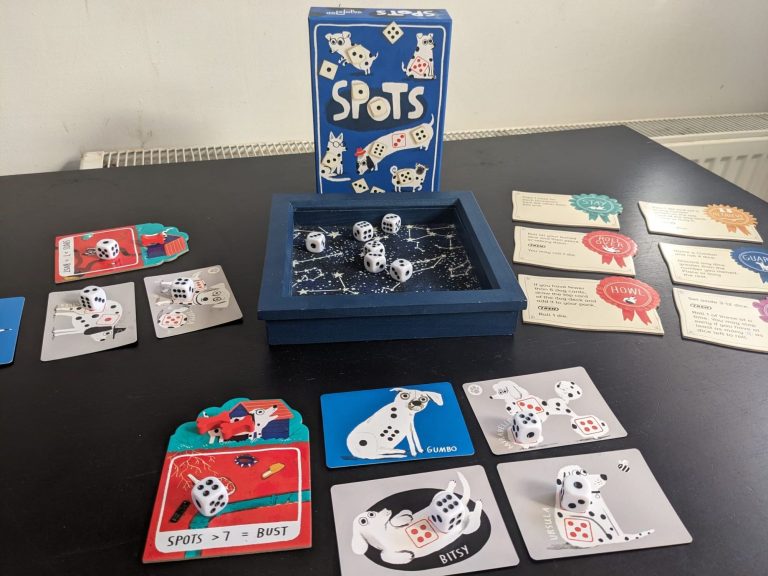

“No plan of operations extends with any certainty beyond the first encounter with the main enemy forces” – Helmuth von Moltke
We have good news and bad news.
Good news: We are a lot closer to releasing our game than we thought we were!
Bad news: At least for now, there won’t be a physical release for the game… Allow me to explain via a boardgame metaphor.
This week we played Spots, a push-your-luck dice game. Rolling lots of dice provides more opportunity to score but it also puts you at a higher risk of going bust and losing all your progress. As we played, we egged each other on to roll that extra dice here and there. Although it was fun and exciting (as Mat put it, gambling fires all the right neurons) the game took twice as long as it should have because everyone at the table was going bust. If someone had just stayed the course, played slow and steady, they would have won for sure.
What has this got to do with releasing our own game? Well, our dream was to publish a beautiful physical card game. But our dream has bumped into reality. First of all, we don’t have much of an audience right now (if you are reading this, thank you from the bottom of our hearts) so a big capital investment on a few hundred copies of our game is a big risk – it is rolling a lot of dice. We could go the Kickstarter route but we’re not too fond of that idea, maybe we’ll talk about why some other time.
Secondly, the printing company we have been speaking to don’t make a box the size/shape we have envisioned. We could just have a different shaped box but we have been starting to learn and think about the game as a product – it needs to be attractive to retailers and customers, as well as playing well on the table. Alternatively, we could work with another manufacturer but we want to work with local businesses and we can’t find anyone else who will print in the volumes we want and a price we can stomach.
So, in Helmuth’s words, we have encountered the enemy forces. But we are not giving up. Instead we are switching tack and looking to release the game as a print-and-play (PNP) which has some benefits to you:
- It will be way cheaper to buy!
- You will be able to play it sooner!
And it has benefits to us:
- It will be way cheaper to make!
- We can build our audience with less risk!
- We can easily revise the game at little to no cost, not that we intend to release a broken game!
- Anything we make from our game will support our future projects!
So, that’s the end of story time for this week. Stay well and look out for our PNP release in the near future!
- Rob & Mat
April11th 2025 Game Dev Mega Blog
The last two weeks have seen much activity at FLG headquarters!
A new card list for Genome, sporting a new and intriguing mechanic as well as a streamlined rule set
Mat's first game of Terraforming Mars
FLG's first crack at Kill Team
*Genome*
Development on Genome continues. We're pleased to say that we've managed to metaphorically throw out the chaff and bolster or wheat yield. There were some untidy mechanisms making the play experience a little clunky and some rule interactions that were confusing or ambiguous. Paring back and simplifying the game on the whole, while maintaining the driving mechanic, has vastly streamlined play and boosted the fun! The game now plays in approximately half the time it did before and deciding on a strategy is far easier!
Mat materialised a new card list (version 4) based on some of our findings which has smoothed out the occurrence of bonus player actions, called codons, while maintaining their overall occurrence. We've found players are fare less likely to have "dead hands" and if you can't do something of benefit for yourself, you're usually able to disrupt your opponent while you get back on track!

We have made codons more frequent and more consistent across games, also by altering the points scoring slightly we have been able to strongly reward players for using codons by having them lead to more points.
If you've been keeping tabs on this blog, you'll know the aim of the game is to make sets of the DNA bases, A, T, C & G. In a DNA strand, these bases pair up, A with T, C with G. We've tied this real-world element into our game by having a top and bottom base on each card and by adding the ability to spin cards to change which base is being read to form sets. A somewhat small change that has lead to some really interesting moments in-game!

A updated card design an a new action appears!!
*Terraforming Mars*
Rob introduced Mat to Terraforming Mars (TM) this week. TM is a heavy-weight sci-fi engine-builder which Rob and his wife picked up during the COVID pandemic. It's one of Rob's favourites! Rob and Mat, joined by their beautiful better halves, battled it out to be the most contributory corporation in the race to terraform the red planet. Mat enjoyed his first experience, despite taking last place - a tip for your next game "more trees, less degrees"!

Mat's first play of a classic.
*Kill Team*
Mat had more luck with Kill Team, taking a decisive victory over Rob's Plague Marines with his clean and clinical Space Marines in the first of many battles. Rob made a major mis-play, charging his wounded soldier headlong into a bloodthirsty assault intercessor - a tip for Rob's next game "Nurgle's blessing 'disgusting resilience' ain't no match for chainsword brilliance"

Two squads face off, Death Guard Vs Deathwatch.

Two Death Guard prepare to enguage an Assault Marine (It didn't end well).
Well, that's enough for today! Make sure to follow us on instagram for more updates on Genome and our gaming highs and lows!
March 21th 2025 Game Dev Blog
"Not all those who wander are lost…” – J.R.R Tolkien
Boy, did we wander this week; Sunday saw our first attendance at the Yorkshire Play Testers group held at the Leeds Traveling Man. Mat got to see some cool prototype games from other designers and to share our game, Genome, with new players. We had lots of useful feedback but perhaps too useful…
The feedback we received centred around theme and scoring. To us, non-chemists, the theme and mechanics tied quite nicely but one play tester picked holes in our abstraction of reality regarding the DNA theme. Our current iteration of Genome focuses on creating poker-like sets to earn points. This method of scoring poses two challenges:
1.How do we encourage players to create larger sets, and
2.How do we keep the game interesting for multiple plays with the same target sets every game.
We immediately began work on both changing theme and scoring methods. This has been the focus of our week seeing much ideation and problem solving, however as we began to plan updates, we found that we were basically designing a new game. It may have been centred around the core mechanics of Genome, but it was distinctly different. At this point several important lessons in game development were revealed to us.
•Always be aware of the scope and goals of the development (don’t let your game wander too far from your original vision)
•Listen to play testers but don’t bend to their every whim
•Theme is very important. Picking the right theme and emulating it to the right level of detail can provide some flexibility in terms of design.
When we set out to make Genome, we had a vision; a small-format DNA-themed card game with a tight rule set. We narrowed down on a final design with two core mechanics and a simple scoring system. However, some of the changes we made to meet playtesting feedback departed from our original vision.
We managed a reality check before we went too far down the rabbit hole and we’re now back on track, tweaking the game we have, rather than designing a brand new one. As an upshot of this we have a concept for a game founded on the same systems of Genome that we can make in the future.
Once we noticed the scope of the game was changing hugely, we were able to think objectively about what we were changing and why. When we took the time to look at the data, we realised we were making all these changes based on the feedback of one or two people. Considering this, we were just as likely to remove something that people enjoyed as we were to fix something a hand full of people didn’t like. Going forwards, we are hoping to focus on the number of times we receive certain feedback, not just the enthusiasm with which it is given.
Finally, when exploring a new theme, we found that the interaction of theme and mechanics is incredibly important. This is especially relevant to players who have some knowledge of the theme’s subject area. For example, when considered changing the theme from DNA-sequencing to planning a gymnastics routine, Rob (a former gymnast) struggled to envision the game reflecting the reality of gymnastics. This helped us to reflect on the inaccuracies of Genome and how it may irritate players with knowledge in that area.
So, we have learnt a lot this week and made some progress on a game that will now be another project for the future. But everything we have learnt will go into making Genome a better game.
Thanks
Mat & Rob
March 21st 2025 Game Dev Blog

Our first printed prototype. It feels great to have gotten this far.I cannot wait to put together a Rev 2
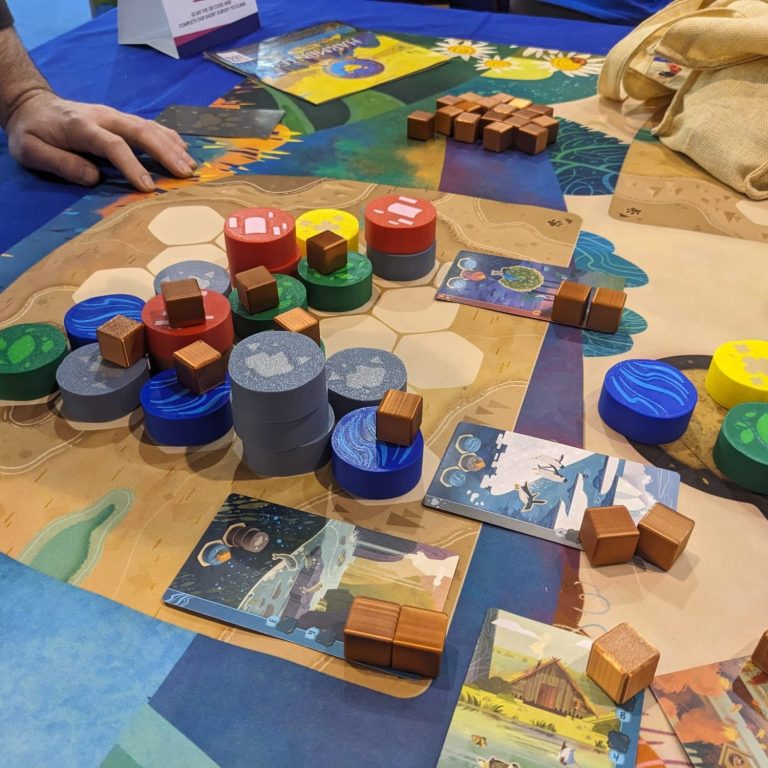
We were able to play a giant version of harmonies at Aircon. A great game with some Azul like vibes.

We also managed to play some Dark Dungeons a great co-op dungeon crawling game. Unfortunatly we didn't win.
“Continuous improvement is better than delayed perfection.” – Mark Twain
It has been a busy week since our last post with some big first milestones crossed. We attended Aircon, saw some great new releases, play tested Genome with some members of the public and received or first prototype deck!
Mat attended Aircon (a boardgame convention held locally to us) on both Saturday and Sunday putting in a strong showing at the Crockinole Tournament and playing some great new games such as Harmonies and Dark Dungeons. More importantly he was able to convince some innocent members of the public to play test Genome.
The play testing went well, with all players understanding and enjoying the game. Some recurring feedback we encountered were a need for player aid cards and clearer card icons, which we are working on now. It was great playing our game with strangers and seeing them realise the deeper strategies inherent in the game as they grappled with their hand of cards.
As a consequence of all the boardgaming (especially the play testing) our heads were abuzz with design ideas. We were able to think of solutions to some design challenges that had been present in the game for some time, such as managing scoring and encouraging larger genes (tricks) as well as determining methods for walking players through creating and activating codons and indicating used cards. This was great as it helped us to further push the games development, but it does mean we have more work to do!
In addition to play testing, we received our first prototype deck (unfortunately on the Monday after Aircon). The process of putting together this prototype has been very educational as we have had to learn the basics of managing designs for printing, such as working within safe areas and filling bleed areas. We were really happy with the quality of the print and the feel of the cards and cannot wait to test this deck out with new players.
From all the events of the week we have some very clear next steps to progress Genome along the path to a fully realised game. For our next version of the game, we plan to:
•Redesign the card art to ensure a more consistent visual finish when accounting for bleed and cut variation.
•Redesign the action icons on the card to improve legibility
•Produce updated rules to account for new scoring and codon tracking approaches.
Wow, what a busy week and lots of new tasks to do off the back of our play testing and prototype evaluation. Come back next week for more news on our steady progress!
March 14th 2025 Game Dev Blog
"It does not matter how slowly you go so long as you do not stop." – Confucius
We're steady away with our first game, Genome, and have overcome a bit of a slump this week.
We've been gradually improving the comprehensibility of the rules. We are at a point where the rules are so much more digestible than before but we're now finding knots and tangles in the gameplay.
It would be easy to view this as more than a small step back, but in actual fact it is a giant leap in the right direction! The clarified rules are facilitating gameplay and revealing edge cases that would otherwise have gone under the radar. And now we can fix them!
The goal is to improve player experience but what we're changing are the mechanics. So, there is some relationship between the two that we have dubbed "Mechanistic Influence" (for no other reason than to sound clever) and we think it looks like this.

If we know what we want the game feel and player experience (outputs) to be then we can evaluate how our changes to the game mechanics (inputs) serve those goals.
•Do the mechanics give us the game feel we're aiming for?
•Is the game enjoyable to the player?
In our case, we are coming close to a completed rule set so we are mainly looking to change the deck list (mechanics) and measure the game feel (number of turns, length of game, average scoring rate, etc) to see how this impacts the player experience (how people enjoy the game).
This is a common practice in Quality Management called verification and validation.
But "Mechanistic Influence" sounds cooler.
Thanks for reading! Check back next week for more updates and maybe a preview of our prototype deck!
March 6th 2025 Game Dev Blog
“Give me six hours to chop down a tree and I will spend the first four sharpening the axe” - Anonymous
Our first game, Genome, is coming along nicely.
•We have art that we think is both clear and aesthetically pleasing.
•We have core mechanics that are simple yet interesting.
•We have a rules sheet that is far clearer than our first attempt (and we’re still yet to make a few improvements).
But one major aspect of the game hasn’t changed a great deal since we started - the card list.
The card list is the biggest influence on the feel and pace of the game. Changing what appears on each card and how frequent certain powers are will dictate the flow. So, where do you start when it comes to optimising a card list? There are two options:
1.Make changes based on your gut – Where does it feel like the game is lacking, slow or uninteresting and what can you do to improve that area?
2.Make changes based on data – Quantitatively, how balanced is each card? How likely is it that you have the components to make interesting choices within your 5-card hand?
I think it’s easy to dismiss option 1 but, ultimately, games are about having fun and fun is a feeling, not an equation. So, option 1 is vital in the early stages of game development.
Once you’ve decided the fun is there, option 2 comes into play. A novel idea might be fun once or twice, but if it isn’t well balanced, if one player wins 90% of the time or you frequently have to mulligan or skip because there’s nothing worthwhile you can do, that game will be shelved, and the players will be disappointed.
So how are we “sharpening the axe?”
We assigned a utility & power value to each card component (action, number or item) in our game. Utility describes how often you can play a component and power is that component’s influence on the state of the game. For example, in our game there is a “quantity” component. Naturally, a quantity of 1 will have less power than a quantity of 3 but they have equal utility since they serve the same purpose and are used in the same way. These values allow us to compare each card against the rest of the deck. If a card is low in both utility and power, it will feel like dead weight in your hand. On the flipside, a card with high power and utility might be game-breakingly amazing and give the wielder an unfair advantage. A card with high power and low utility might be strong but only in a specific context. You get the point.
Applying this analytical approach, we were able to increase the average utility of all cards by around half a point whilst maintaining average card power. We also decreased the variability in the deck so card power and utility are more uniform, hopefully leading to a less swing-y play experience. This was partly achieved by standardising the number of components on a card, with almost all cards having 2 active slots in the updated deck list.
We’re yet to test this new card list, but we’re hopeful it will smooth out a few bumps we’ve been noticing!
See you again next week!
- Rob & Mat

This graph shows an increase in utility with little change in power between the two decks. (Deck 1 is the original deck and Deck 2 is the updated deck)

Each dot on this graph represents a type of card in the deck. The graph shows that Deck 2 has a tighter grouping when compared to Deck 1. Most importantly the cards with less utility are removed from Deck 2.
February 28th 2025 Game Dev Blog
“If you can’t measure it, you can’t improve it” - anonymous
In last week’s blog we mentioned our playtesting feedback, and how we’re trying to make best use of our playtesters.
We developed a Likert questionnaire, which is the fancy name for those “strongly agree to strongly disagree” scales you’ve seen a hundred times. It turns out a lot of thought goes into those questions (if the questionnaire is good).
The way a question or statement is phrased can influence the answers you receive. For example, asking “how obvious were the game mechanics” leads, or even shames the questionee into answering positively. We tried to avoid leading or loading the questions to get the least biased responses possible.
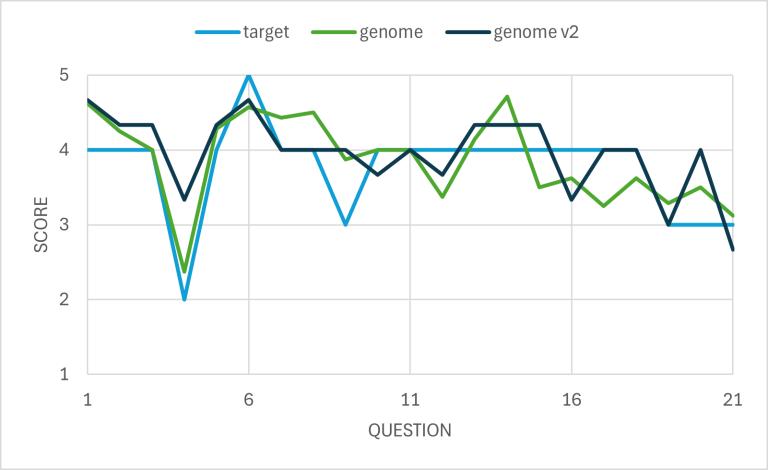
Initial playtesting and version 2 results for Genome plotted against target values. this helps us to steer efforts in game development.
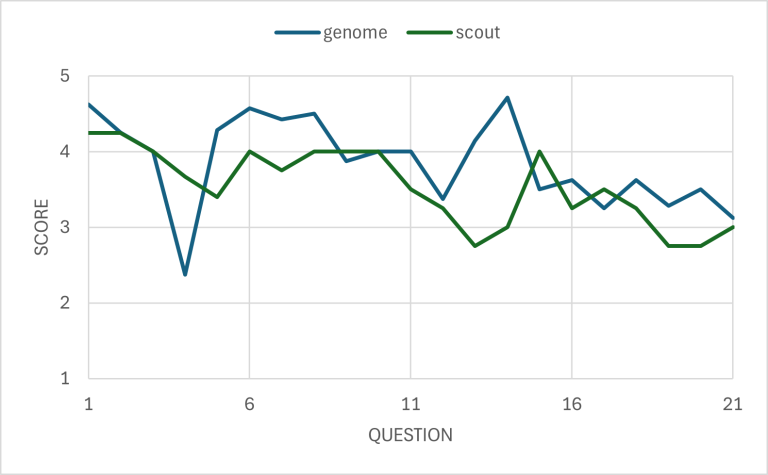
A comparison of Genome and Scout (a comparable game). these sorts of comparisons help us to determine how we are performing vs the rest of the market.
Our questionnaire had five sections:
1.Likert scales for game experience (fun, clarity, luck vs skill)
2.Likert scales for theme, mechanics and components
3.Likert scales for the rules comprehension and presentation
4.Likert scales for game length, depth and complexity (these are all things that need to hit a sweet spot. A game can’t be too fun or too clear but it can be too long or too short so the scales for these questions need to be a bit different)
5.A place for people to tell us what kind of games they like to play. If we have a playtester who only likes 6-hour session legacy games and they rate Genome, our small format, 15-30 min card game, poorly, that’s probably not a big deal. We have a broad target audience but not everyone will be into everything, and that’s okay!
So, that’s how we’re gathering feedback. Mat has worked wonders with the data to benchmark our game’s performance against similar games (Scout, Dino Days). This lets us see where we’re falling short and need to improve Genome. By tracking versions too, we can see if the changes we’re making are actually improving the game.
Thanks for reading! Follow us on Instagram to stay up to date with our progress. We should shortly have a prototype Genome deck in our hands so you’ll get a glimpse of that very soon!
February 20th 2025 Game Dev Blog
I like criticism it makes you strong - Lebron James
Playtesting is a truly awful, and yet totally necessary, element of game development. You put your beloved little project in front of someone else for the first time and watch as they practically tear it to shreds in front of your very eyes. But it is necessary. Luckily, Mat and I are engineers in an industry where verification and validation of our work is common – In other words, we are used to the hacking and slashing of our output in the name of iterative improvement.
We wanted to share our first experiences of playtesting with you and talk about how the process has started to shape our first game, Genome.
Our first playtests were informal games played with colleagues, friends and family. These games were guided (meaning we supported the players with rules clarifications and tactical suggestions). These first tests revealed some shortcomings in our rule set.
•Firstly, the rules were worded poorly; the language we used made it difficult to comprehend their intent. For example, whilst reading them, my sister said to me “nothing is going in.”
•Secondly, they were ambiguous about what should happen in certain circumstances. We were able to address this ambiguity, leaning into the DNA theme to make thematic and therefore intuitive limitations. For example, if a codon is broken (cards removed/rearranged) then it can no longer be used for any remaining activations.
On the bright side, we saw the intended emergent mechanics were present. Players were able to chain actions together to do big and surprising things. Best of all, it was exciting for everyone at the table and rewarding for the responsible player when this happened. People were having fun!
Having made notes on these early games, it was clear to us that we’d need to be more systematic in our gathering of feedback. We developed a Likert questionnaire (see picture) where players could rank their experience against several statements from “Strongly agree” to “Strongly disagree” – something we’ll talk more about next week. These were generalised so that we can use them again for future projects.
We ran some more formal, unguided playtests (players were given the rules and provided with no other advise), gathering feedback via the questionnaire and will share our insights in future blogs.
We have learned a lot already. On a number of occasions, we have said to each other “I think we’re there” only to rehash a handful more rules, so we’ve likely got plenty more testing and adjusting to do! But we can also take solace in the fact that we have indeed created a real game.
We can’t wait to continue our boardgame design adventure and will share more playtesting details with you next week.
See you then,
Rob and Mat
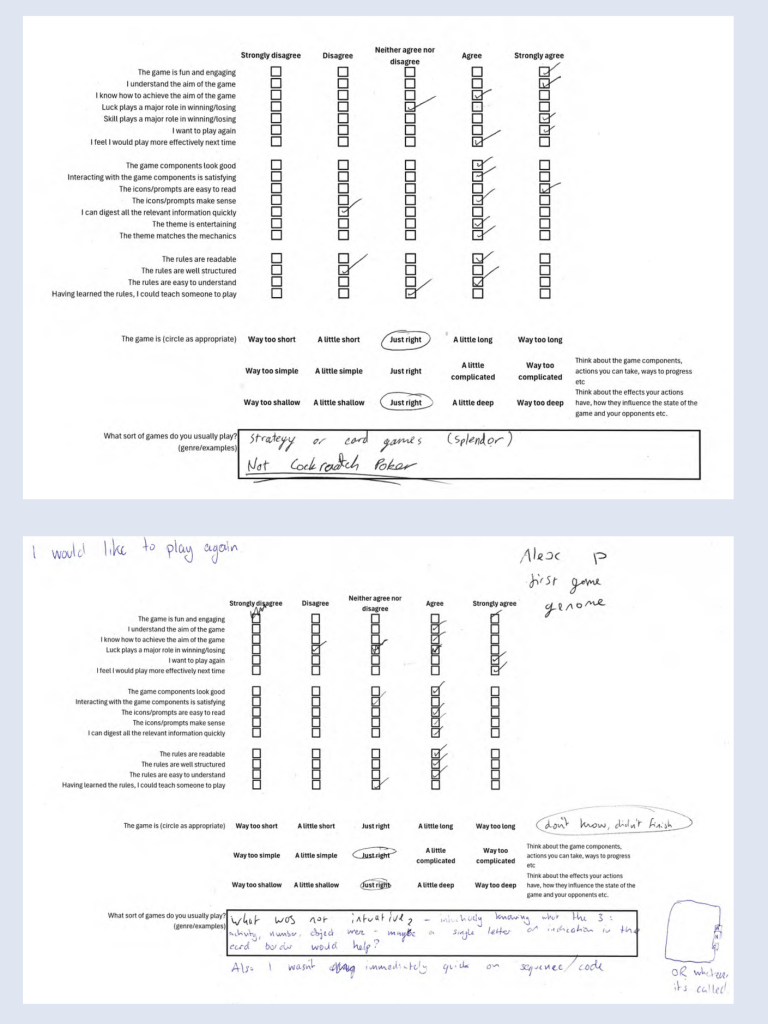
Some example Likert questionnaires. Play testers filled these in after playing and we entered the data into a spreadsheet for assessment (we will talk about this next week)
February 13th 2025 Game Dev Blog
“There will be obstacles. There will be doubters. There will be mistakes. But with hard work, there are no limits.” — Michael Phelps
This week we wanted to provide more details on Genome, our in-development game.
In this DNA-themed card game, race to beat your opponents and be the first to unlock the human genome by discovering genes!
You will build your DNA strand by playing cards into a sequence. There are two core mechanics: Genes and Codons.
Genes are collected to earn points and win the game. They are formed by making poker-like hands with the four bases, A, T, C & G. See the top-right image for examples.
Codons are three-card combinations that, if arranged in order, create an instruction allowing a player to add, swap and remove cards from their own or others' sequences. See the bottom-right image for examples.
Each codon requires an action component, a number component and an item component.
- the action tells you how the codon can manipulate a sequence.
- the number tells you how many times the codon can be used.
- the item tells you what to apply the action to.
By skillfully arranging and executing codons, players can create more or bigger genes allowing them to leapfrog the competition.
We have some more realised prototypes ready for play and have begun to test the concept.
We have enjoyed our journey so far and hope you continue to follow along with us. Next week we will give some details on our playtest findings and the tools we have used to make the most of our playtest data!

Here are a few "genes" that you can form as part of the game. A three-of-a-kind (CCC, TTT, etc) and a straight (TAGC, GCAT, etc). Genes are made by combining bases (the letters on the cards).
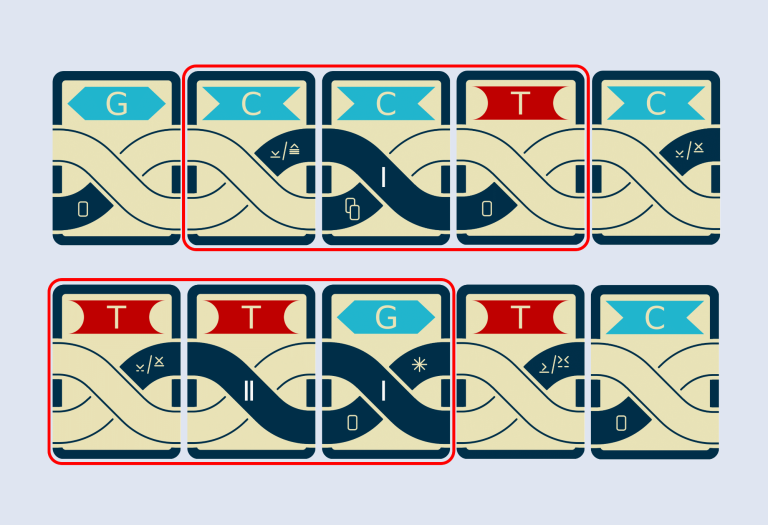
Codons are created by combining an action-number-item sets, in order. Codons let players do things like play or draw 1 card (top codon) or splice or remove two cards (bottom codon).
February 7th 2025 Game Dev Blog
“The beginning is the most important part of the work.” – Plato
Genome is Ferret-Legging Games’ first game development project. We thought, to give ourselves the best chance at success, let’s start simple – A trick-taking game with a twist. Or rather, a helix.
The idea came to us during an office coffee break as we spit-balled hypothetical ideas for a BoardGameGeek game jam. The theme was letters.
We came up with maybe a half a dozen concepts in as many minutes. A worker placement game themed around Paul’s letters to the early church, a game set during WWII based on postal censorship, a dexterity game about [REDACTED]. But the one that stuck was a game about combining the letters, or bases, of DNA to form certain combinations, or proteins.
Mat’s early prototype, 50 slips of rough-cut paper with hand-written instructions, was enough to tell us this was worth pursuing. So, we have.
We’re on card list V2 and rule set V3 at this point but the bones haven’t changed. We have some preliminary card art that we’re happy with and some early playtesting results that confirm our hunch.
We’re making a game.
In the next few dev blogs, we’ll share some of our first experiences with playtesting and the current rules for Genome. Follow us on Instagram and sign up for email alerts to stay up-to-date.
Thanks,
Rob & Mat
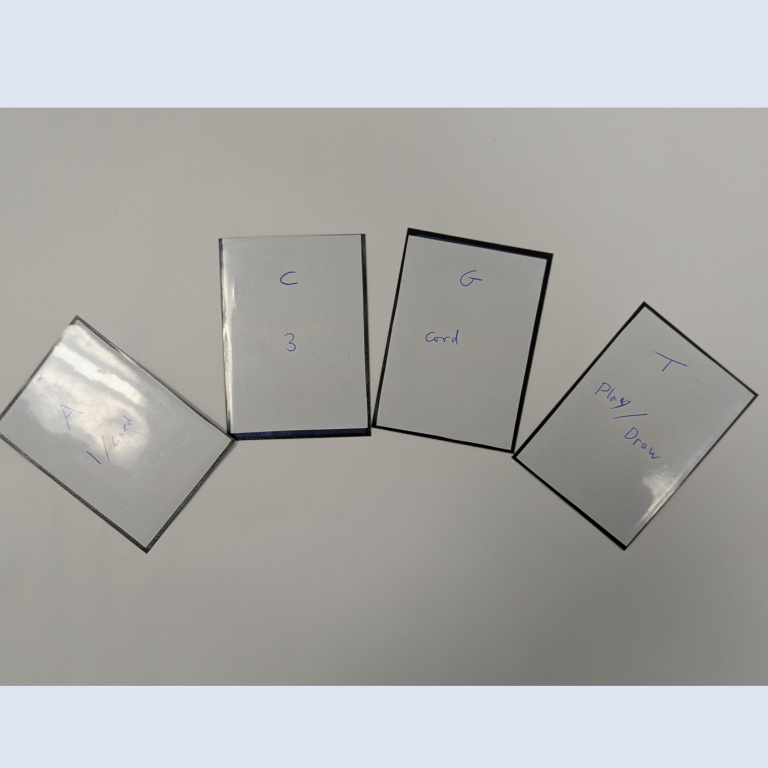
The first prototype of Genome. Not pretty, but entertaining.

Genome Version 2. Once we knew the game was worthwhile we produced cards with improved layout and readability to fix some of the immediate problems we encountered.
© Copyright. All rights reserved.
We need your consent to load the translations
We use a third-party service to translate the website content that may collect data about your activity. Please review the details in the privacy policy and accept the service to view the translations.
